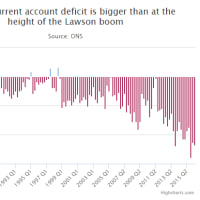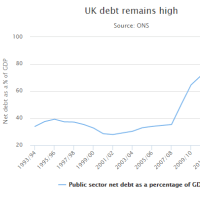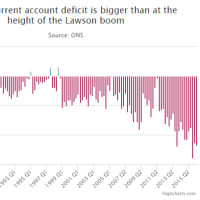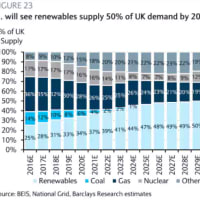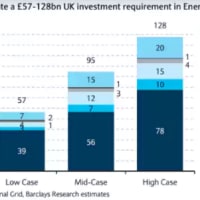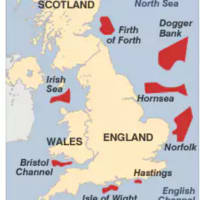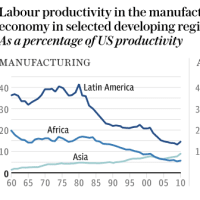古い記事~、古い記事~。
The world's commodity supercycle is far from dead
(世界の商品スーパーサイクルの終わりはまだ遠い)
By Ambrose Evans-Pritchard, International business editor
Telegraph: 7:46PM GMT 02 Dec 2012


The world's commodity supercycle is far from dead
(世界の商品スーパーサイクルの終わりはまだ遠い)
By Ambrose Evans-Pritchard, International business editor
Telegraph: 7:46PM GMT 02 Dec 2012
Great resource booms usually end abruptly, catching almost everybody by surprise.
大資源ブームは通常、突然終了して、ほぼ全ての人々を仰天させるものです。
The rhythm is as old as mankind. It is poignantly described Nobel laureate Halldor Laxness through the life of an Icelandic sheep farmer a hundred years ago in Independent People, harrowing because his ruin is so utterly human.
そのリズムは人類と同じくらいの歴史を持ちます。
ノーベル賞受賞者のハルドル・ラクスネス氏が、100年前のアイスランドの羊飼いの人生を通じて『Independent People』に鋭く描かれています。
羊飼いの破滅が余りにも人間らしいがために、恐ろしいのです。
Studies by the World Bank covering two centuries of data sketch a pattern of 10-year supercycles, followed by a slide for the next 20 years or so as excess investment leads to a flood of supply. The long bear market can be cruel for those hanging onto to resource stocks, convinced that the rebound must be nigh.
2世紀分のデータを網羅した世銀の調査は、過剰投資が供給過剰をもたらすことによって次の20年程度下降する、10年間のスーパーサイクルのパターンを描き出しました。
長期的なベア・マーケットは、リバウンドは間近に違いないと確信して、資源銘柄にしがみついている人々にとって、冷酷たり得ます。
Mark Ryder, Australian investment chief for UBS, says we are reaching just such an inflexion point as China's manic construction phase gives way to more sedate growth, and Europe, America, and Japan take their fiscal medicine. "The commodity super cycle's end is at hand. The scene is set for a momentum shift," he said.
UBSのオーストラリア人のインベストメント・チーフ、マーク・ライダー氏によれば、中国の狂気じみた建設フェーズがより落ち着いた成長に道を譲り、欧州、米国、日本が財政再建に乗り出す中で、僕らはちょうどそんな転換点に至りつつあるのだそうです。
「商品スーパーサイクルの終焉はすぐそこだ。この光景はモメンタムが変わる用意は整っている」と同氏は言いました。
This view is daily dinner talk in Australia, a country that lives off iron ore and coal sales to China - and described contentiously by Dylan Grice from Societe Generale as "a credit bubble built on a commodity market built on an even bigger Chinese credit bubble".
この見解は、鉄鉱石と石炭の対中販売で食べているオーストラリアでは、毎日話題に上っており、ソシエテ・ジェネラルのディラン・グライス氏には「これまで以上に巨大な中国信用バブルの上に作られた商品市場の上に築かれた信用バブル」と喧嘩腰で評されました。
It is starting to take hold as the new consensus in the City where funds are keeping a close eye on the mining trio of BHP Biliton, Rio Tinto, and Brazil's Vale. All three are battening down the hatches as hopes fade that this year's 23pc fall in iron ore prices will soon reverse. Rio is cutting $5bn in spending by 2014. Vale is expected to pare back its $40bn investment plans next week.
これはファンドがBHPビリトン、リオ・ティント、ヴァーレの三大鉱業会社に注目し続けるシティの新たな常識とされ始めました。
三社とも、今年は23%も下落した鉄鉱石価格が間もなく再上昇するかもしれない、との希望が消えつつある中で、危機への備えを進めています。
リオ・ティントは2014年までに支出を50億ドル削減し、ヴァーレは来週、400億ドルの投資計画を縮小すると予想されています。
But it is a report by Citigroup's Edward Morse that has most rattled resource. He claims that America's shale gas revolution - which has cut US natural gas prices by 70pc - is a taste of what will happen across the gamut of commodities as vast investment comes on stream. The inference is that parking money in "long-only" resource index funds - worth $250bn - has become a mug's game.
しかし、資源業界を最も同様させたのは、シティグループのエドワード・モース氏のレポートです。
米国のシェール・ガス革命(米国の天然ガスの価格を70%引き下げました)こそ、巨額の投資が急激に集まる中で、様々な商品を通じて起こる事態の一端を垣間見せている、と同氏は主張しています。
「ロング・オンリー」の資源指数ファンドに資金を投資しておくこと(2,500億ドル相当)はカモネギだとほのめかしているのです。
It is the classic pincer movement of supply and demand, with Chinese imports of iron, copper, coal, and oil cooling at just the wrong moment. "It is now clear the commodity super-cycle is over. The overall slowing and the restructuring of the Chinese growth model should mark a watershed in global commodity markets. For many industrial metals, China, in fact, was responsible for all of net global demand growth after 1995," he said.
これは古典的な需要と供給の挟み撃ちの動きです。
中国勢の鉄、銅、石炭、石油の輸入が間違ったタイミングで冷え込んでいます。
「商品のスーパーサイクルが一巡し切ったのは今や明らかだ。全体的な減速と中国の成長モデルの再構築は、世界の商品相場の転換点を印したはずだ。多くの工業金属については、実は、中国が1995年以降の世界需要の純増させたのは全て中国だった」とモース氏は言います。
To be precise, China's share of total world demand in 2011 was: soya (27pc) cotton (38pc), aluminium (40pc) iron ore (40pc), coal (42pc), zinc (42pc), lead (43pc), copper (43pc), and lean-hogs (50pc).
厳密には、2011年の世界総需要に占める中国の割合は、大豆が27%、綿が38%、アルミニウムが40%、鉄鉱石が40%、石炭が42%、亜鉛が42%、鉛が43%、銅が43%、豚赤身肉が50%です。
Mr Morse says China's growth will slow from 10.5pc to 5.5pc by 2020 - Credit Suisse thinks it could be as low as 4pc, and the US Conference Board 3.7pc - but the crucial twist is that appetite for resources will wane as the Politburo calls time on history's greatest building boom in history and opts instead for a modern, sleek, consumer and service-driven economy.
モース氏によれば、中国の成長は2020年までに10.5%から5.5%に減速するだろうとのことです(クレディ・スイスは最悪4%、米国産業審議会(CBC)は3.7%)。
しかし、中国共産党政務局が史上最大の建設ブームに待ったをかけて、モダンで、スマートで、消費者とサービス主導型の経済を選ぶ中で、資源への需要が減退する展開となれば大変なことです。
This then is the argument of the bears, one that many of us will have to grapple with over coming months. If they are right, it will churn up the global investment landscape, rippling through the currency markets. Much of the London Stock Exchange is a resource play, either directly or through Russian and Kazakh companies and such-like that feed off commodity economies. But are they right?
そしてこれはベア派の主張であり、今後数ヶ月間に僕らの多くが立ち向かわなければならなくなる多くの主張の内の一つです。
ベア派が正しければ、それは世界の投資見通しをかき回し、為替相場を通じて広がるでしょう。
ロンドン市場の参加者のほとんどは、直接的またはロシアやカザフスタンの企業などの商品経済で食べている企業経由で間接的に、資源を取引しています。
しかし、ベア派は正しいのでしょうか?
It is not entirely clear to me why a such a China would be energy frugal. The country is to add 125m cars over the next five years, half the entire US fleet, which will have to be parked in multi-story blocks or below ground. Petrol at the pump costs 66p a litre, so it is not exactly rationed. (Saudi Arabia is worse of course: it costs 5p for diesel).
中国がどうしてこれほどエネルギーに淡泊になるのか、僕にははっきりわかりません。
この国では今後毎年1,250万台も自動車が増えますが、これは米国の自動車台数の半分に相当します。
これらの自動車は立体駐車場か地下駐車場に停めなければならなくなります。
ガソリン価格は1リッター66ペンスですから、配給制というわけではありません。
(サウジアラビアは言うまでもなくもっと酷い状況で、ディーゼルで1リッター5ペンスです。)
In any case, the Reserve Bank of Australia - keenly alert to the China's story - disputes the basic premise. It argues in a report that construction will not peak in absolute terms for another five years as 20m rural migrants pour into the cities each year. The pace will not slow much until the urbanisation rate reaches 70pc in 2030.
いずれにせよ、中国情勢を熱心に観察するオーストラリア中銀は、大前提に反論しています。
同行はレポートの中で、都市部に毎年2,000万人の移民が地方から雪崩れ込むので、まだ5年間は絶対的にはピークに達しないとしています。
2030年に都市化率が70%に達するまで、ペースが大きく鈍化することはないだろうとのことです。
The RBA said China's growth will become more "steel-intense" - not less - as building shifts to high-rise blocks and urban sophistication. "Steel used in residential construction will peak around 2024, at a level that is 30 per cent higher than in 2011," it said.
オーストラリア中銀によれば、建物が高層化し都市が洗練される中で、中国の成長はより「鉄中心」になる(のであって軽減されるのではない)そうです。
「住宅建設に用いられる鉄は2024年頃にピークを迎える。2011年の水準を30%上回る水準になるだろう」
I have made two trips this year to cities deep in the interior and it is hardly a secret that Chengdu, Chongqing, Xi'an, Changsha, and Kunming and others are attempting to replicate the East Coast booms with their own metropolitan extravaganzas over the next decade.
僕は今年2度、中国内陸部の都市を訪れましたが、成都、重慶、西安、長沙、昆明などは公然と今後十年間にメトロポリス建設祭で東沿岸部のブームを真似しようとしています。
Chengdu's planning chief told me the Hukuo feudal system that keep peasants stuck in their villages is being dismantled in Sichuan, opening they way for a fresh wave of migration. She expects her city to grow from 14m to 20m by 2020.
成都の都市計画のトップは僕に、農民が村に縛り付けられる制度は四川省では解体されており、新たな移民の波に門戸を開きつつあると話しました。
彼女は成都の人口は2020年までに1,400万人から2,000万人に増加すると予想しています。
Nor is it clear that the Communist Party is yet ready to wean the country off state credit, top-down planning, and chronic over-investment, an addictive model for Maoist patronage.
また、政府の信用供与、トップダウン計画、慢性的過剰投資といった、毛沢東主義支援への中毒的モデルから国を解放する準備が中国共産党にあるかどうかも、よくわかりません。
China's Development Research Council knows that the catch-up model launched by Deng Xiaoping in 1978 is no longer fit for purpose as China moves up the technology ladder.
中国国務院発展研究センターは、1978年に小平が開始したこのキャッチアップ・モデルが、中国がテクノロジーの梯子を上る中では、もはや目的にそぐわないということを知っています。
Yet the Party's 10-year power transition last month seems to have been a victory for hardliners. Key reformers were shut out of the seven-man Standing Committee. The North-Korea trained Zhang Dejiang has tightened his grip, a boon to the state-owned behemoths. It looks as if the Politburo may try to keep the infrastructure blitz going for another cycle, extending it to the 800m or so people of the hinterlands.
しかし、先月行われた中国共産党の10年に一度の政権交代は、強硬派の勝利に終わったように見えます。
主な改革派は7人の委員からなる常任委員会から締め出されました。
北朝鮮で訓練を受けた習近平主席は、公営巨大企業には朗報なことに、支配力を強めました。
政務局はインフラ投資のサイクルをもう一度回して、内陸部に住む8億人の人民へと拡大しようとしているようです。
This is fatal for China. Such a course risks ensnaring the country in the "middle income trap" over the long-run. But in the short-run - say another five-year cycle - it could kindle a fresh burst of uber-growth, with demand cascading through the Asian tigers and the commodity complex.
これは中国にとって致命的です。
そのような路線は、同国を長期的に見て「中所得国の罠」にかける危険があります。
しかし短期的、例えば5年サイクルで見ると、新たな急成長に火を点けて、需要はアジアの新興国やコモディティ・コンプレックス全域に広がります。
Standing back, you might argue that commodities have held up remarkably well this year given that Europe has crashed back into double-dip slump, that the US slowed to stall-speed over the early summer, and that China itself has been through a quasi-recession with falling electricity use and rail freight, and a collapse in steel output.
一歩引いて、ヨーロッパが二番底に陥ったこと、米国の経済成長が初夏はゼロに停滞したこと、そして中国そのものが準不況状態を経験し、電力使用量も鉄道輸送量も減少した上に、鉄の生産も激減したことを考えれば、商品相場は今年は極めてよくもったと言うことが出来るかもしれません。
For Brent crude to trade at $111 a barrel in such a bleak world suggests that Asia's industrial revolutions have pushed oil prices to a structurally higher plateau. Energy costs may well punch higher once the next cycle of growth is under way.
そのような状況でブレント原油に1バレル111ドルの値が付くことは、アジアの産業革命が石油価格を構造的により高い水準まで押し上げたことを示唆しています。
エネルギー費は、次の成長サイクルが進めば、更に押し上げられる可能性が高いかもしれません。
No doubt the Malthusian narrative - peak this, peak that - at the top of the commodity boom four years ago was overblown. The US energy revival has shown how quickly human ingenuity can sweep away assumptions.
4年前の商品ブームの頂点で言われた、これもピークに達する、あれもピークに達する、マルサス的な物語が大げさだったことは間違いありません。
米国のエネルギー・リバイバルは、どれほど素早く人間の知恵が推測を圧倒出来るかを見せつけました。
Yet all the nagging worries about resource depletion are still there. New supplies of oil are mostly deep in the ocean beneath of layers of salt, or in Russia's arctic High North, or in Canadian tar sands at a production cost of $90.
とはいえ、資源不足に関する全ての懸念は消えていません。
石油の新しい供給元の大半は、深海底油田か、ロシアの北極圏の油田か、またはカナダのタール・サンドで、その原価は90ドルに上ります。
The US National Academy of Sciences says that 26pc of all copper that ever existed in the earth's crust has already been lost in usable form for mankind, and to my knowledge this claim has not been refuted. Platinum supplies are even tighter.
全米科学アカデミーによれば、地殻の銅の26%は人類が使ってしまったとのことで、僕が知る限り、この主張への反論は出ていません。
プラチナの供給は銅を上回る厳しさです。
The shift towards an animal-protein diet in China and across Asia continues to gobble up supply of grains as feed, in competition with biofuels. United Nations data shows that the world is losing 12m hectares of arable land each year (Britain's total is 17m) due to urban sprawl and degradation, yet there are an extra 73m mouths to feed each year.
中国およびアジア全土で進む動物性蛋白質への食のシフトは、穀物を飼料として大量に使用し続けており、バイオ燃料と良い勝負です。
国連のデータによれば、世界は耕地を年に1,200万ヘクタールずつ都市化と土地の悪化により失いつつあるそうです(英国の総面積は1,700万ヘクタール)が、人口は年に7,300万人ずつ増加しています。
For two centuries, commodity prices fell ever lower in real terms with the nadir of each cycle, in what is known as the Singer-Prebisch process. The terms of trade seemed forever rigged agaisnt the primary producers.
2世紀に亘って商品価格はサイクルの底毎に実質的に下落してきました(シンガー・プレビッシュ命題)。
取り引きの条件は永遠に一次産品の生産者にとって不利になっているようです。
There is a some evidence that this is finally going into reverse as scarcity takes its revenge. If so, we may find that the supercycle is still in rude good health next year as China cranks up construction again, and America turns the corner.
この仕組みが、不足が復讐に出て、遂に逆転しつつあるという証拠が見られます。
だとすれば、中国が再び建設を強化し米国が不況を脱する来年、僕らはスーパーサイクルがまだ健在であることを知ることになるかもしれません。
And never, ever ignore the global money supply. The key gauge - real six-month M1 - touched bottom at 1.5pc in May. It jumped to 3.7pc in September and seems on the same track for October. The world's kindling wood is crackling again. Can commodities really stay cold?
そして絶対にグローバル・マネー・サプライを無視してはいけません。
この主要指標は5月に1.5%で底入れしました。
9月には3.7%に上昇し、10月もこの路線で進むようです。
世界で燻る熾火がまた炎を上げつつあります。
商品相場は本当に冷え切ったままでいられるのでしょうか?











